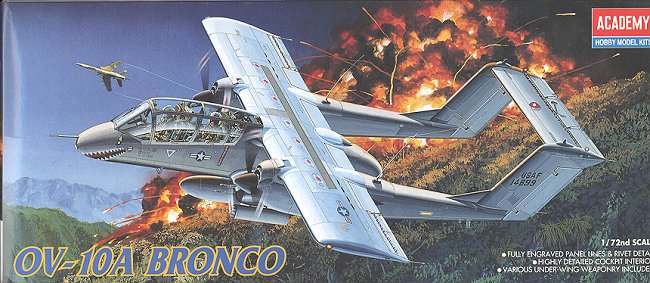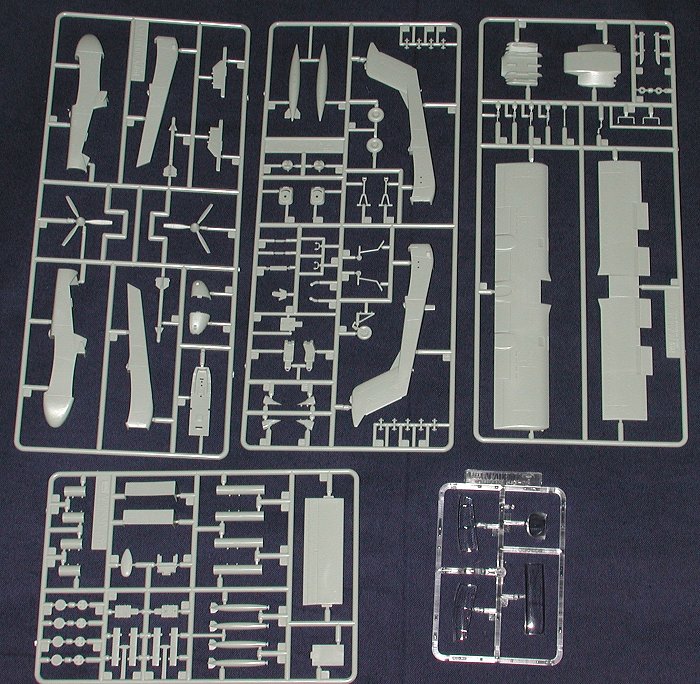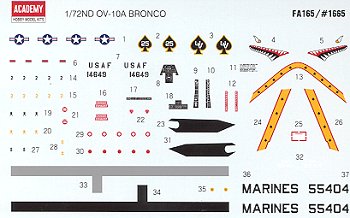
| KIT: | Academy 1/72 OV-10A 'Bronco' |
| KIT # | 1665 |
| PRICE: | $9.50 |
| DECALS: | Two aircraft; see review |
| REVIEW & | |
| NOTES: |

| HISTORY |
In the early '60s, there was a requirement from all US ArmedServices for a Light Attack and Reconnaissance Aircraft (LARA). The aircraftshould also be able to perform the function as a COIN (COunter INsurgency)aircraft as well. This meant that it needed to be able to carry a variety ofordnace in addition to having internal guns. It should also be easy to maintainand equally easy to fly. North American's entry into the field was what waseventually to become the OV-10 'Bronco'.
It is powered by two small turboprops, has four 20mm cannon in ashort weapons pod and is also capable of handling various ordnance including2.75 and 5 inch rocket pods, 1,000 bombs, marker rockets and Sidewinder missilesfor self defense. There is an aft cargo area that can handle two stretchers orfive fully equipped troops.
The OV-10 was first introduced in the last few years of theVietnam War as a replacement FAC (Forward Air Controller) to replace the CessnaO-2A. It was an instant success as it was armed, better protected and fasterthan the O-2. It was also used by several Marine Corps Squadrons and by one(perhaps two) Navy squadrons as well. After the end of the war, the OV-10 wasstill in use by regular USAF squadrons in both the US and overseas. It is one ofthe few aircraft that was not used by the USAF Air National Guard, those unitsgetting the OA-37B instead. The final USAF OV-10 was retired in the late 1980swith the last USMC versions being retired in the early 1990s.
| THE KIT |

Until this kit appeared, there were only two other OV-10s in1/72 scale, that from Airfix and another from Hasegawa. Both are not new kits,first seeing the light of day in the late 1960s shortly after the aircraftappeared in service. The Airfix kit was later modified to OV-10D NOGS with thelonger nose, FLIR pod and belly cannon. The Academy kit may look somewhat likethose earlier kits, but is in all effect a new tool. It is completely modernizedwith engraved panel lines and super detail on the rest of the model. There is afull load of ordnance available for the kit and there is an indication thatthere is an OV-10D in the works as some of the sprues are marked as such andthere are cutouts for the addition of chaff dispensers. In addition, the modelerneeds to cut away some later addition antennas to do the early versions that areoffered with this kit.
The instructions are very good showingcolors where needed as well as what needs to be done to do either an air forceor marine version. Colors are generic other than for the exterior camouflagewhich gives FS numbers. Something I need to research is that the instructionscall for insignia white wheel wells and I recall seeing OV-10s with chromateyellow wells. I should have a slide of that somewhere in my collection.
 Decalsare given for both a USAF and USMC OV-10A. The USAF version is from the 20thTASS at DaNang, South Vietnam in 1969. It is painted an overall ADC grey FS16473 with a white upper wing. It also has a shark mouth to add some interest.The other is a HML-267 OV-10A from Camp Pendleton, CA in 1970. It is FS 34097green upper with FS16440 light gull grey undersides and a white upper wing. Thereason for the white upper wing is so that the strike group could spot theaircraft against the ground so have an idea of where to place their ordnance. Inaddition to the kit decals, which look very nicely done, there are a few oldMicroscale sheets of the OV-10 that may still be around.
Decalsare given for both a USAF and USMC OV-10A. The USAF version is from the 20thTASS at DaNang, South Vietnam in 1969. It is painted an overall ADC grey FS16473 with a white upper wing. It also has a shark mouth to add some interest.The other is a HML-267 OV-10A from Camp Pendleton, CA in 1970. It is FS 34097green upper with FS16440 light gull grey undersides and a white upper wing. Thereason for the white upper wing is so that the strike group could spot theaircraft against the ground so have an idea of where to place their ordnance. Inaddition to the kit decals, which look very nicely done, there are a few oldMicroscale sheets of the OV-10 that may still be around.
Overall,it looks like a very nice kit. Probably the only difficulty will be findingwhere to stuff the nose weight to keep it from tail-sitting!
Review kit courtesy of me and my wallet!
If you would like your product reviewed fairly and fairly quickly by asite that has over 1,500 visits a day, please contactme or see other details in the